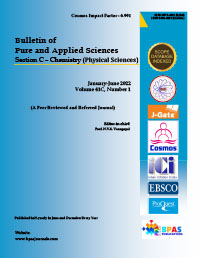Removal of Phenol from Waste Water Using Various Agricultural Waste Adsorbents
DOI:
https://doi.org/10.48165/bpas.2023.42C.2.6Keywords:
Phenolic Compounds, Agricultural Waste Adsorbents, Adsorption CapacityAbstract
Phenolic compounds are categorised as hazardous pollutants that contaminant groundwater. The principal objective of this article was to organising effective adsorbents for the removal of phenol and it’s derivative. In this review article, a compelling amount of published paper were consulted in order to provide information about various agricultural waste adsorbents. Agricultural waste adsorbents have been modified by thermal and chemical process to enhance the surface area properties. This article has suggested that increasing the adsorbent dosage increases the adsorption capacity. The pH, adsorption capacity, reduction efficiency and temperature have been investigated for various adsorbents in this article. This study proved that agricultural waste adsorbents are effective in removal of phenol from waste water.
Downloads
References
Solomon, W. (1995) Environmental Impact of Metals Derived from Mining Activities: Processes, Predictions, Prevention. Journal of Geochemical Exploration, 52, 5-23.
Ikenaka, Y., Nakayama, S.M.M., Muzandu, K., Choongo, K., Teraoka, H., Mizuno N. and Ishizuka, M. (2010) Heavy Metal
Contamination of Soil and Sediment in Zambia. African Journal of Environmental Science and Technology, 4, 729-739.
Harrad, S. (2001). Persistent Organic pollutants, Environmental Behaviour and Path Ways for Human Exposure. Kluwer Academic Publishers, Norwell.
Kümmerer, K. et el (2009) The Presence of Pharmaceuticals in the Environment Due to the Human Use. Journal of Environmental Management, 90, 2354-2366.
Jimoh Abdulfatai et el (2013).Development of adsorbent from banana peels for waste water treatment. Applied Mechanics and Materials 248, 310-315.
AAM Akl, Dawy MB, Serage AA (2014) Efficient Removal of Phenol from Water Samples Using Sugarcane Bagasse Based Activated Carbon. J Anal Bioanal Tech 5, 189.
D. Sathya Priya, M.V. Sureshkumar (2019). Synthesis of Borassusflabellifer fruit husk activated carbon filter for phenol removal from waste water. International Journal of Environmental Science and Technology, 17(1).
G.N. Manju, C. Raji and T.S. Anirudhan. (1998). Evaluation of coconut husk carbon for the removal of arsenic from water. Water Research, 32(10), 3062-3070.
Lalit Kumar, Vikas Yadav, Meenakshi Yadav, Neha Saini, Karthikeyan Jagannathan and Vajjiravelmurugesan (2023). Systematic study on the Effect of structural modification of orange peel for remediation of phenol from contaminated water. Water Environ Res. 95, e10872.
Al-Taie, A.H., Mamat, N.F., Abdullah, M.F., & Ismail, K. (2016). Adsorption of methylene blue onto acid-treated mango peels: Kinetic, equilibrium and thermodynamic study. Desalination and Water Treatment, 59, 210-219.
Sadon, F.N., Ibrahem, A.S., & Ismail, K.N. (2012). An overview of rice husk applications and modification techniques in wastewater treatment. J Purity Utility Reaction Environ. 1, 308-34.
Azamzam, A.A., Rafatullah, M., Yahya, E.B., Ahmad, M.I., Lalung, J., Alam, M., & Siddiqui, M.R. (2022). Enhancing the Efficiency of Banana Peel Bio-Coagulant in Turbid and River Water Treatment Applications. Water, 14(16), 2473;
Muhammad Burhanuddin Bahrodinet al (2022). A novel natural active coagulant agent extracted from the sugarcane bagasse for waste water treatment. Appl. Sci., 12(16), 7972.
C Namasivayam, D Sangeetha. (2008). Application of coconut coir pith for the removal of sulphate and another anions from water. Desalination. 219(1), 1-13.
S Tunchaiyaphum, MN Eshtiaghi, N Yoswathana (2013). Extraction of bio active compounds from mango peels using green technology, International Journal of Chemical Engineering and Applications. 4 (4), 194.
BEE Hegazy, Hanan A Fouad, Ahmed M Hassanain (2012). Brick manufacturing from water treatment sludge and rice husk ash, Australian Journal of Basic and Applied Sciences. 6 (3), 453-461.
Abia, A. A., Horsfall, M., Jr, & Didi, O. (2003). The use of chemically modified and unmodified cassava waste for the removal of Cd, Cu and Zn ions from aqueous solution. Bioresource technology, 90(3), 345–
Tonni Agustiono Kurniawan et al (2005). Comparisons of low cost adsorbents for treating waste water laden with heavy metals. 2005.
De Gis, S., Giusy Lofrano, G., Grassi, M. and Notarnicola, M. (2016). Characteristics and Adsorption Capacities of Low-Cost Sorbents for Wastewater Treatment: A Review. Sustainable Materials and Technologies, 9, 10-
